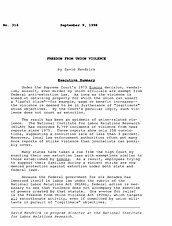The result has been an epidemic of union-related violence. The National Institute for Labor Relations Research (NILRR) has recorded 8,799 incidents of violence from news reports since 1975. Those reports show only 258 convictions, suggesting a conviction rate of less than 3 percent. Moreover, local law enforcement authorities often get many more reports of strike violence than journalists can possibly cover.
Many states have taken a cue from the high Court by enacting their own extortion laws with exemptions similar to those established by Enmons. As a result, employees trying to support their families during a violent strike are now denied protection against extortion under both state and federal laws.
Because the federal government for six decades has immersed itself in labor law under the rubric of the National Labor Relations Act (NLRA), federal action is necessary to see that violence does not accompany the exercise of powers created by that statute. One avenue for relief is the Freedom from Union Violence Act (FUVA), which targets all extortionate activity, even if committed by union militants in pursuit of “legitimate” objectives.

